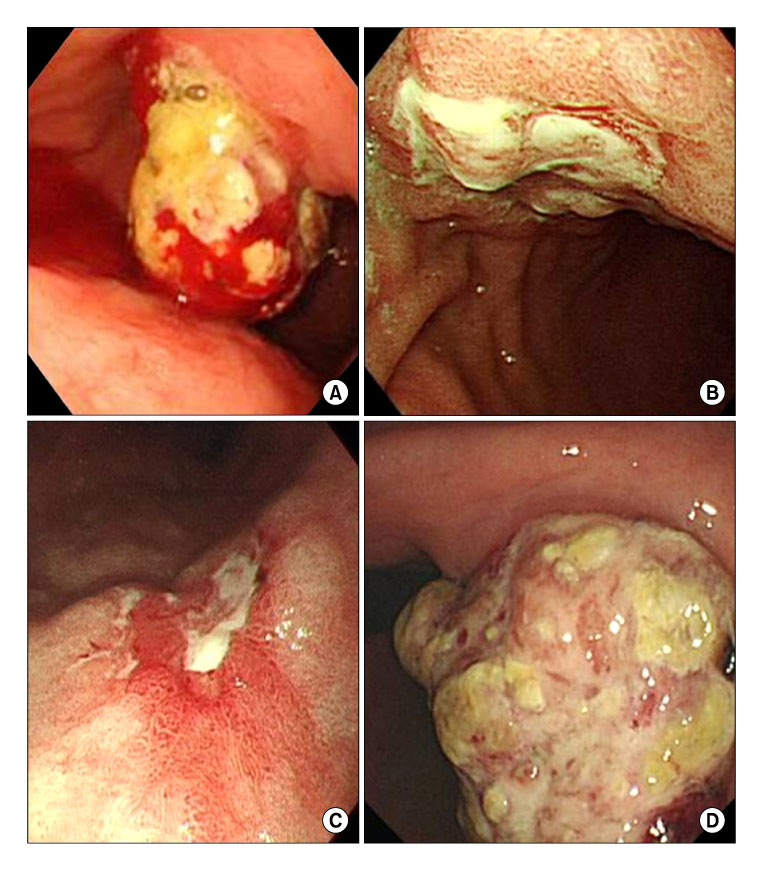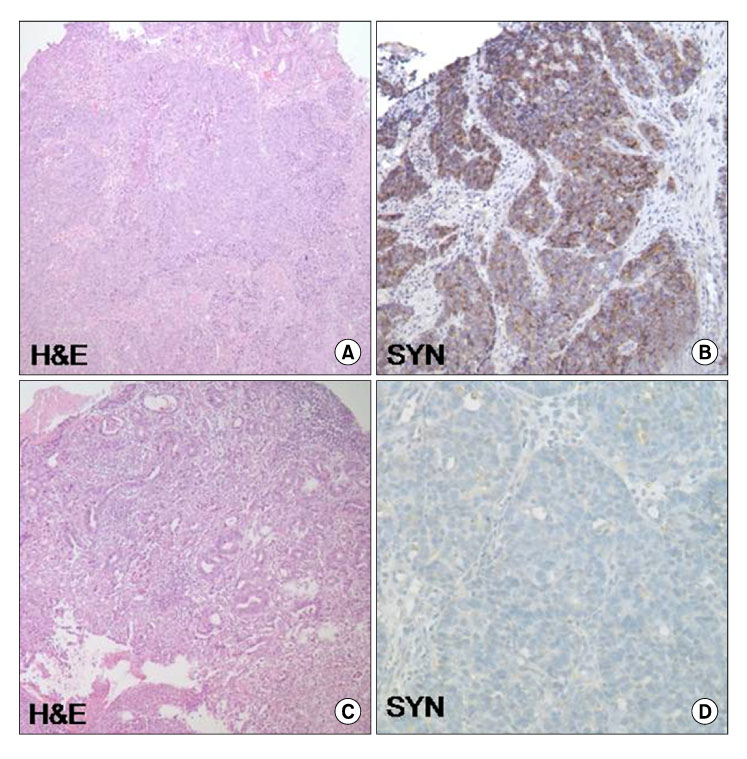Chonnam Med J.
2008 Dec;44(3):188-193. 10.4068/cmj.2008.44.3.188.
A Case of Gastric Adenocarcinoma Developed in Neuroendocrine Carcinoma after Chemotherapy
- Affiliations
-
- 1Division of Hematology-Oncology, Chonnam National University Medical School, Gwangju, Korea. shcho@chonnam.ac.kr
- KMID: 2172301
- DOI: http://doi.org/10.4068/cmj.2008.44.3.188
Abstract
- A 69-year-old male visited our medical center with hematemesis. Gastrofibroscopy revealed a 4.5 cm sized fungating mass on anterior wall of gastric lower body. Biopsy specimens showed a carcinoma of neuroendocrine components with strong positive for synaptophysin stain. Because he had a metastatic neuroendocrine carcinoma with multiple metastasis of liver, we treated him with chemotherapy of etoposide and cisplatin. The primary lesion showed nearly complete response after 6th cycles of chemotherapy, however it was regrowed with chemoresistance and mutifocal lesion in stomach and liver. Endoscopic biopsy on same previous lesion revealed a poorly differentiated tubular adenocarcinoma with negative for synaptophysin. After conversion to another tumor type, the treatment outcome was progressed in spite of salvage chemotherapy for gastric adenocarcinoma. He died 17 months after diagnosis. The immunohistological change of same mass after chemotherapy suggests a possibility of other course of differentiation from common pleuripotent cells of adenocarcinoma and neuroendocrine carcinoma after chemotherapy.
Keyword
MeSH Terms
Figure
Reference
-
1. Gilligan CJ, Lawton GP, Tang LH, West AB, Modlin IM. Gastric carcinoid tumors: the biology and therapy of an enigmatic and controversial lesion. Am J Gastroenterol. 1995. 90:338–352.2. Plöckinger U. Diagnosis and treatment of gastric neuroendocrine tumors. Wien Klin Wochenschr. 2007. 119:570–572.
Article3. Godwin JD 2nd. Carcinoid tumors. An analysis of 2,837 cases. Cancer. 1975. 36:560–569.4. Choi YC, Roe IH, Lee JH, Park SS, Lee DH. Synchronous association of carcinoid tumor with adenocarcinoma of the stomach. Korean J Gastroenterol. 1988. 20:421–425.5. Yamashina M, Flinner RA. Concurrent occurrence of adenocarcinoma and carcinoid tumor in the stomach: a composite tumor or collision tumors? Am J Clin Pathol. 1985. 83:233–236.
Article6. Kim YE, Park KC, Kwon JG. A case of double primary cancer-early gastric adenocarcinoma associated with adenocarcinama and carcinoid. Korean J Gastroenterol. 2003. 42:533–538.7. Shin DG, Kim BS, Jang SJ, Choi WY, Kim YJ, Yook JH, et al. Neuroendocrine carcinoma of the stomach: a clinicopathologic study of 18 cases. J Korean Gastric Cancer Assoc. 2003. 3:191–194.
Article8. Ronellenfitsch U, Ströbel P, Schwarzbach MH, Staiger WI, Gragert D, Kähler G. A composite adenoendocrine carcinoma of the stomach arising from a neuroendocrine tumor. J Gastrointest Surg. 2007. 11:1573–1575.
Article9. Rayhan N, Sano T, Qian ZR, Obari AK, Hirokawa M. Histological and immunohistochemical study of composite neuroendocrine-exocrine carcinomas of the stomach. J Med Invest. 2005. 52:191–202.
Article10. Balkelund K, Fossmark R, Nordrum I, Waldum H. Signet ring cells in gastric carcinomas are derived from neuroendocrine cells. J Histochem Cytochem. 2006. 54:615–621.
Article
- Full Text Links
- Actions
-
Cited
- CITED
-
- Close
- Share
- Similar articles
-
- Gastric Collision Tumor (Adenocarcinoma and Neuro-endocrine Carcinoma): A Report of Two Cases
- Gastric Adenocarcinoma with Coexistent Hepatoid Adenocarcinoma and Neuroendocrine Carcinoma: A Case Report
- A Case of a Gastric Composite Tumor with an Adenocarcinoma and a Large Cell Neuroendocrine Carcinoma
- Gastric Collision Tumor Consisting of Mucinous Carcinoma and Large Cell Neuroendocrine Carcinoma: A Case Report
- Metastatic Large Cell Neuroendocrine Carcinoma Combined with Gastric Adenocarcinoma




